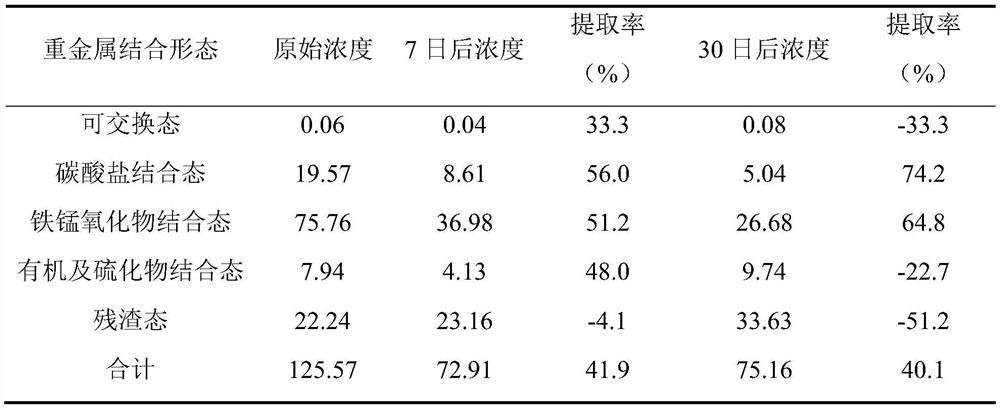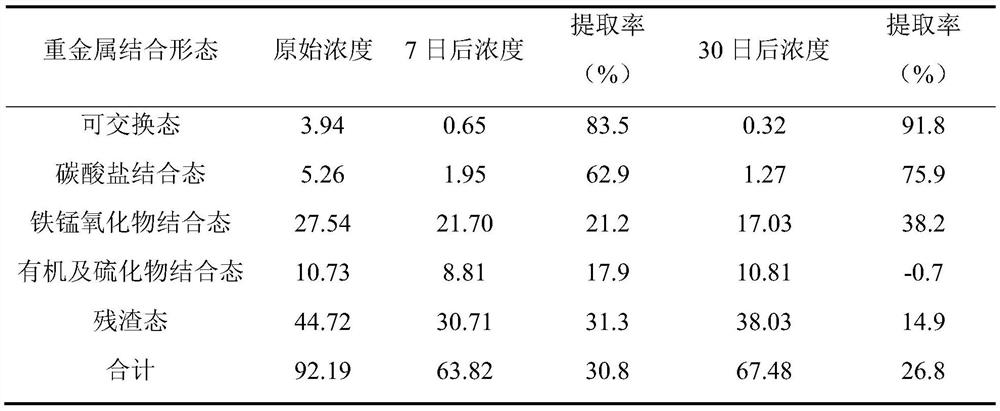Application of a Soil Extractant in Treating Lead Contaminated Soil
The technology of lead-contaminated soil and extractant is applied to the application field of soil extractant in the treatment of lead-contaminated soil, can solve the problems of secondary pollution, secondary precipitation, and repair rate of less than 3%, and achieves simple and convenient preparation and operation process. The effect of good adsorption performance and stable recovery rate
- Summary
- Abstract
- Description
- Claims
- Application Information
AI Technical Summary
Problems solved by technology
Method used
Image
Examples
Embodiment 1
[0026] To prepare the soil extractant:
[0027] The soil extractant is composed of biochar and magnetic powder. Among them, biochar and magnetic powder (with Fe 3 o 4 ) with a mass ratio of 2:1
[0028] Prepared by:
[0029] Step 1, preparing biomass carbon, using peeled wheat straw, after washing, air-drying, and crushing, the temperature is raised to 300°C under the condition of an initial temperature of 25°C and a heating rate of 20°C / min with limited oxygen. And after maintaining high temperature pyrolysis for 4 hours, airtightly cool to 25°C, remove surface ash, and pass through 80-mesh sieve for later use.
[0030] Step 2, the composite process is as follows: 2-2.5 parts by mass of biochar passed through 80 mesh, put it into a 1L beaker, dissolved 2.5-3 parts by mass of ferric chloride hexahydrate in 150ml deionized water, and then took 1-1.1 Parts by mass of ferrous chloride tetrahydrate were dissolved in 50ml of deionized water, the two iron-containing systems wer...
Embodiment 2
[0033] In this example, the soil extractant obtained in Example 1 is used for soil pollution control in Jiyuan, Henan Province. The soil extraction point is located in Jiyuan, with a range of about 4 mu. The wheat stubble is removed, and the topsoil is about 20cm deep. TOC accounted for 0.97%. pH6.36. The original moisture content is 4.77%, and the saturated moisture content is 30.16%. The dosage of the soil extractant is 5% (mass ratio), and the specific test method is to select the magnetic biochar (0.3725g) made by mixing 0.25g biochar with 5g soil sample to test in a 50ml centrifuge tube, add 35ml to remove Ionized water, after use, cover tightly and shake on a shaker at 110rpm. Samples were taken for testing after 7 and 30 days.
[0034] Table 2 shows the background concentration, post-remediation concentration and removal rate of lead heavy metals. Among them: the total amount of lead in the soil is digested by the three-acid method, and the content of different for...
Embodiment 3
[0039] The soil extractant obtained in Example 1 is used for soil sample pollution control in Hunan. The soil extraction point is located in a certain county in Hunan Province. The soil is extracted from multiple points. When the soil is extracted, the wheat stalk stubble without rot on the ground is removed, and the surface soil is about 20 cm deep. . pH5.49. Table 3 shows the background concentration, post-remediation concentration and removal rate of lead heavy metals. The original moisture content is 10.03%, and the saturated moisture content is 38.45%.
[0040]Table 3 The effect of soil extractant on the extraction of lead in Hunan soil Unit: mg / kg
[0041]
[0042] According to the above data, the soil extractant can achieve a relatively good effect in 7 days for the treatment of lead-contaminated soil, and stabilize at this effect in 30 days. In the actual application process, the extraction of lead in the soil can be completed within 7 days of application.
PUM
 Login to View More
Login to View More Abstract
Description
Claims
Application Information
 Login to View More
Login to View More - R&D
- Intellectual Property
- Life Sciences
- Materials
- Tech Scout
- Unparalleled Data Quality
- Higher Quality Content
- 60% Fewer Hallucinations
Browse by: Latest US Patents, China's latest patents, Technical Efficacy Thesaurus, Application Domain, Technology Topic, Popular Technical Reports.
© 2025 PatSnap. All rights reserved.Legal|Privacy policy|Modern Slavery Act Transparency Statement|Sitemap|About US| Contact US: help@patsnap.com


